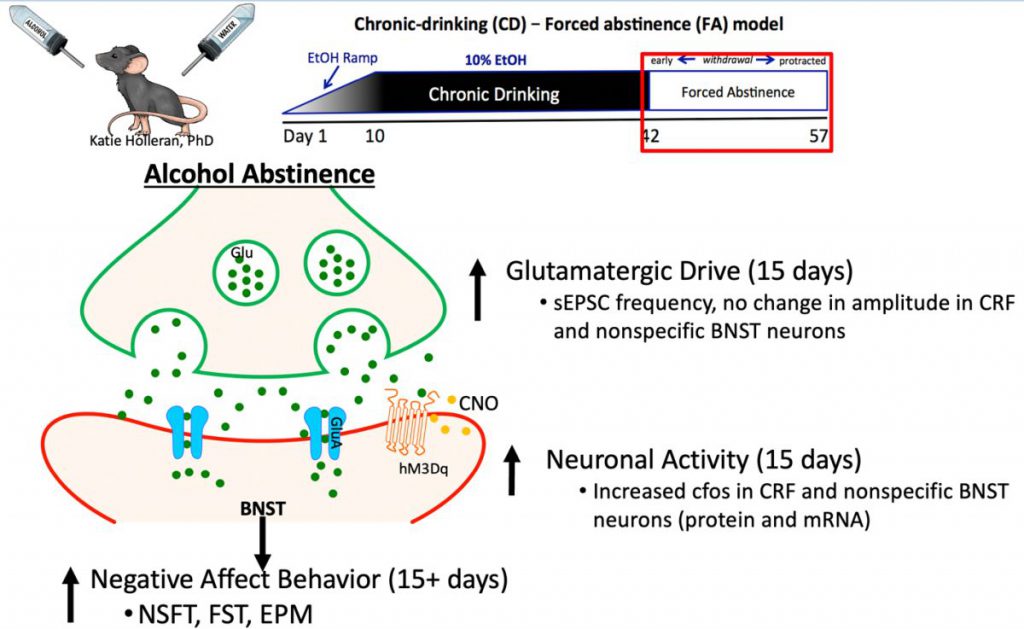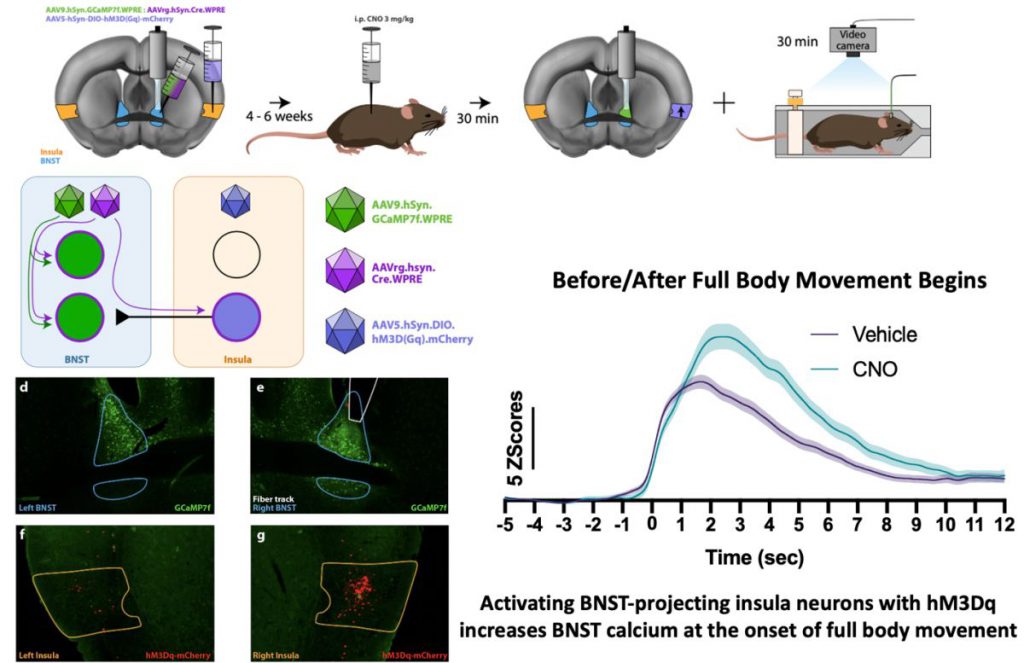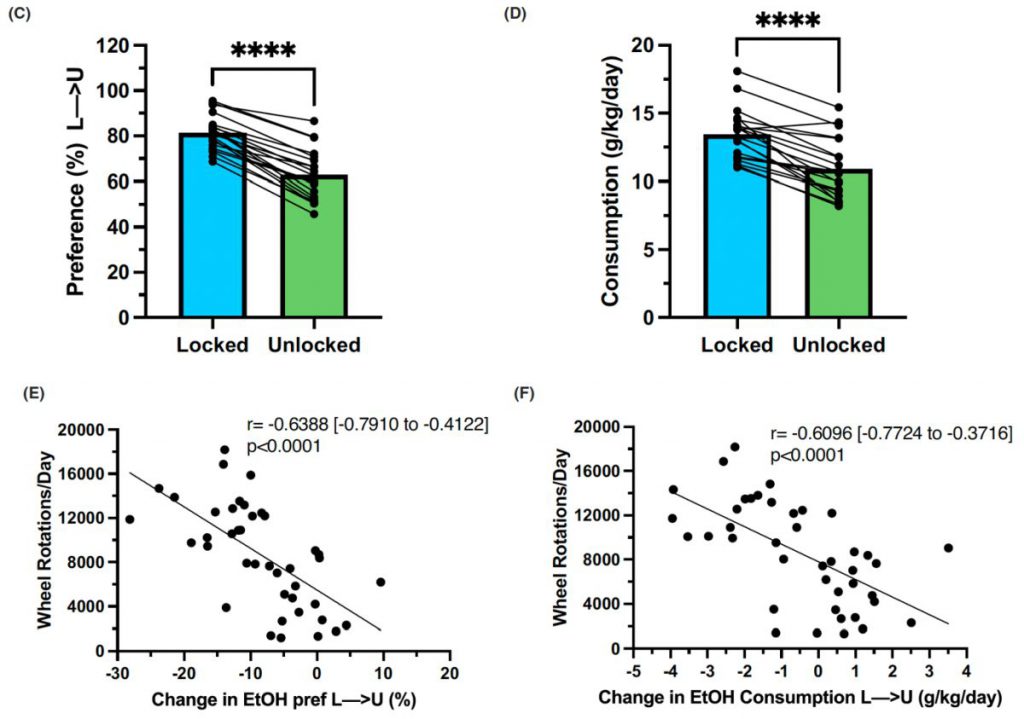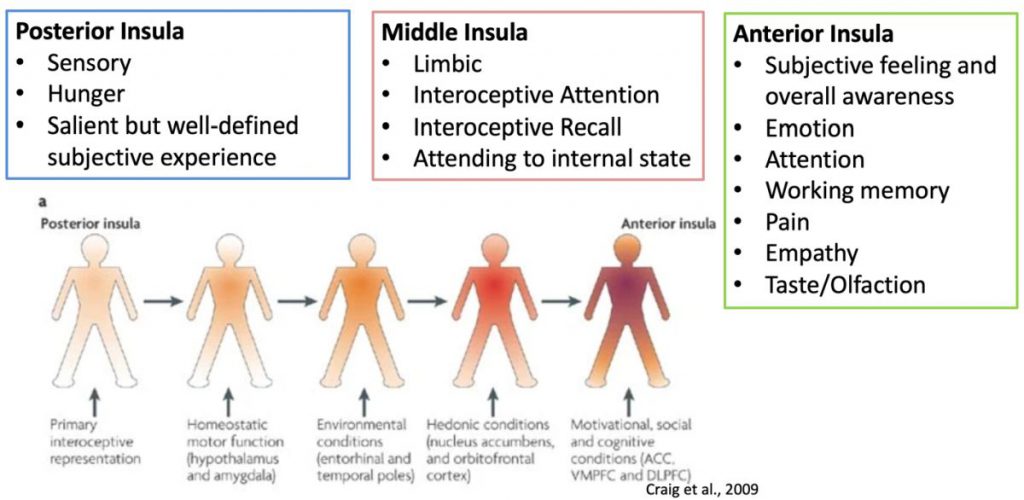Endocannabinoid control of the insular-bed nucleus of the stria terminalis circuit regulates negative affective behavior associated with alcohol abstinence.
Authors: Centanni SW, Morris BD, Luchsinger JR, Bedse G, Fetterly TL, Patel S, Winder DG.
Published in: Neuropsychopharmacology. 2019 Feb;44(3):526-537

Negative affect is a core symptom domain associated with an array of neurological and psychiatric disorders and is only partially targeted by current therapies, highlighting the need for better, more targeted treatment options. This study focuses on negative affective symptoms associated with prolonged alcohol abstinence, one of the leading causes of relapse. Using a mouse model of chronic alcohol consumption followed by forced abstinence (CDFA), prolonged alcohol abstinence increased c-fos expression and spontaneous glutamatergic neurotransmission in the dorsal bed nucleus of the stria terminalis (dBNST), a region heavily implicated in negative affect in both humans and rodents. Further, pharmacologically enhancing endogenous cannabinoids (eCB) with JZL184 prevents abstinence-induced increases in dBNST neuronal activity, underscoring the therapeutic potential of drugs targeting the brain’s eCB system. Next, we used a channelrhodopsin-assisted mapping strategy to identify excitatory inputs to the dBNST that could contribute to CDFA-induced negative affect. We identified the insular cortex (insula), a region involved in regulating interoception, as a dense, functional, eCB-sensitive input to the dBNST. Using a chemogenetic strategy to locally mimic eCB signaling, we demonstrate that the insula strongly influences the CDFA behavioral phenotype and dBNST neuronal activity. Lastly, we used an anterograde strategy for transynaptic targeting of Cre expression in combination with a Gq-DREADD to selectively recruit dBNST neurons receiving insula projections. Chemogenetic recruitment of these neurons mimicked behavioral and c-fos responses observed in CDFA. Collectively, this study supports a role for the insula-BNST neural circuit in negative affective disturbances and highlights the therapeutic potential of the eCB system for treating negative affective disorders.
Delineation of an insula-BNST circuit engaged by struggling behavior that regulates avoidance in mice.
Authors: Luchsinger JR, Fetterly TL, Williford KM, Salimando GJ, Doyle MA, Maldonado J, Simerly RB, Winder DG, Centanni SW.
Published in: Nature Communication. 2021 Jun;12(1):3561.

Active responses to stressors involve motor planning, execution, and feedback. Here we identify an insular cortex to BNST (insula→BNST) circuit recruited during restraint stress induced active struggling that modulates affective behavior. We demonstrate that activity in this circuit tightly follows struggling behavioral events and that the size of the fluorescent sensor transient reports the duration of the struggle event, an effect that fades with repeated exposure to the homotypic stressor. Struggle events are associated with enhanced glutamatergic-and decreased GABAergic signaling in the insular cortex, indicating the involvement of a larger circuit. We delineate the afferent network for this pathway, identifying substantial input from motor-and premotor cortex, somatosensory cortex, and the amygdala. To begin to dissect these incoming signals, we examine the motor cortex input, and show that the cells projecting from motor regions to insular cortex are engaged shortly before struggle event onset. This study thus demonstrates a role for the insula→BNST pathway in monitoring struggling activity and regulating affective behavior.
The impact of intermittent exercise on mouse ethanol drinking and abstinence-associated affective behavior and physiology.
Authors: Centanni SW, Conley SY, Luchsinger JR, Lantier L, Winder DG.
Published in: Alcohol: Clinical and Experimental Research. 2021 Nov

Background: Negative emotional states are associated with the initiation and maintenance of alcohol use and drive relapse to drinking during withdrawal and protracted abstinence. Physical exercise is correlated with decreased negative affective symptoms, although a direct relationship between drinking patterns and exercise level has not been fully elucidated.
Methods: We incorporated intermittent running wheel access into a chronic continuous access, two-bottle choice alcohol drinking model in female C57BL/6J mice. Wheel access was granted intermittently once mice established a preference for alcohol over water. After 6weeks, alcohol was removed (forced abstinence) and mice were given continuous access to unlocked or locked wheels. Negative affect-like behavior, home cage behavior, and metabolic activity were measured during protracted abstinence.
Results: Wheel access shifted drinking patterns in the mice, increasing drinking when the wheel was locked, and decreasing drinking when unlocked. Moreover, alcohol preference and consumption were strongly negatively correlated with the amount of running. An assessment of negative affect-like behavior in abstinence via the novelty suppressed feeding and saccharin preference tests (SPT) showed that unlimited wheel access mitigated abstinence-induced latency increases. Mice in abstinence also spent more time sleeping during the active dark cycle than control mice, providing additional evidence for abstinence-induced anhedonia- and depression-like behavior. Furthermore, running wheel access in abstinence decreased dark cycle sleep to com-parable alcohol- and wheel-naïve mice. Given the positive impact of exercise and the negative impact of alcohol on metabolic health, we compared metabolic phenotypes of alcohol-abstinent mice with and without wheel access. Wheel access increased energy expenditure, carbon dioxide production, and oxygen consumption, providing a potential metabolic mechanism through which wheel access improves affective state.
Conclusions: This study suggests that including exercise in AUD treatment regimens has the potential to reduce drinking, improve affective state during abstinence and could serve as a non-pharmacological approach to prevent the development of an AUD in high-risk individuals.
Better living through understanding the insula: why subregions make all the difference.
Authors: Centanni SW, Janes AC, Haggerty DL, Atwood B, Hopf FW
Published in: Neuropharmacology. 2021 Oct 15;198:108765.

Insula function is considered critical for many motivated behaviors, with proposed functions ranging from attention, behavioral control, emotional regulation, goal-directed and aversion-resistant responding. Further, the insula is implicated in many neuropsychiatric conditions including substance abuse. More recently, multiple insula subregions have been distinguished based on anatomy, connectivity, and functional contributions. Generally, posterior insula is thought to encode more somatosensory inputs, which integrate with limbic/emotional information in middle insula, that in turn integrate with cognitive processes in anterior insula. Together, these regions provide rapid interoceptive information about the current or predicted situation, facilitating autonomic recruitment and quick, flexible action. Here, we seek to create a robust foundation from which to understand potential subregion differences, and provide direction for future studies. We address subregion differences across humans and rodents, so that the latter’s mechanistic interventions can best mesh with clinical relevance of human conditions. We first consider the insula’s suggested roles in humans, then compare subregional studies, and finally describe rodent work. One primary goal is to encourage precision in describing insula subregions, since imprecision (e.g. including both posterior and anterior studies when describing insula work) does a disservice to a larger understanding of insula contributions. Additionally, we note that specific task details can greatly impact recruitment of various subregions, requiring care and nuance in design and interpretation of studies. Nonetheless, the central ethological importance of the insula makes continued research to uncover mechanistic, mood, and behavioral contributions of paramount importance and interest.


